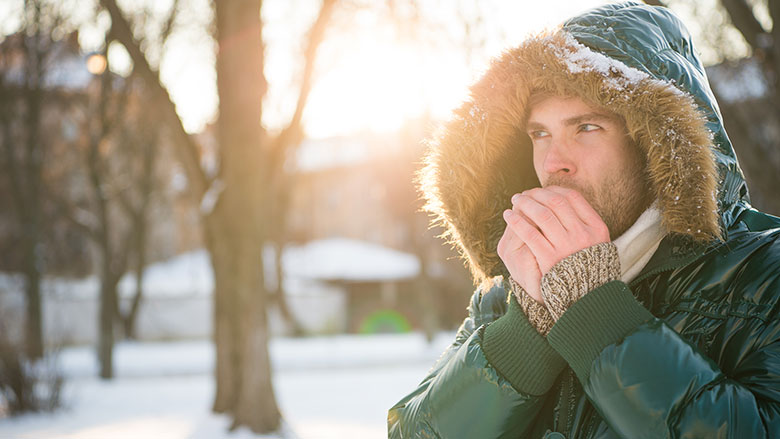Hypothermia is a condition caused by a general cooling of the body which drops a person’s internal core temperature below 98.6 degrees F. It is a common condition that shows itself initially by shivering but, without addressing the early signs of it, can lead to injury, illness, or death.
Most of us have experienced at least mild hypothermia when the body core temperature reaches 95 degrees F, which causes the body to shiver in efforts to generate more internal heat.
The following chart explains what happens with the body as the core temperature drops from cold exposure.
| Internal/Core Body Temperature | Body’s Reaction |
|---|---|
| 98.6 degrees F | Normal conditions |
| 95 degrees F | Body begins to shiver (mild hypothermia reaction) |
| 92 degrees F | Body stops shivering, reaction time slows, metabolism slows, thought processes slow, (moderate hypothermia) |
| 88 degrees F | Sluggish, pale/ashen skin, slowing metabolism, fatigue (severe hypothermia) |
| 85 degrees F | Extremely sluggish, approaching unconsciousness |
Hypothermia affects performance without you knowing it. It does not require freezing temperatures for it to occur; actually, it is most common in ambient air temperatures between 50-60 degrees F.
At 92 degrees F, the body stops shivering. As the core temperature drops, the heart and breathing rates slow and blood pressure drops. The pulse can become irregular, indicating a serious change in the heart’s ability to supply oxygenated blood through the body.
It’s 4 a.m. and cold, so you dress warm for work; by 9 a.m. you are sweating and your clothes are wet from perspiration; by 11 a.m., the overcast turns to drizzle, soaking your outer layer of clothing as the temperature drops a couple degrees; the wind blows and your wet clothes begin to wick heat from your body while the wind evaporates the heated moisture into the air; your body temperature starts to drop.
You begin to shiver and your teeth chatter, but you are determined to finish your work assignment. At 4 p.m., the sun begins to set and the temperature drops quickly. You notice that you stopped shivering, even though you remained outside all day. Your clothes are soaked through; there is a gentle breeze, and you feel fatigued. You sit down to rest; you can’t remember where you parked the car or what you were preparing to do next; suddenly, you feel lost. You are spiraling but don’t know it. Your concentration becomes impaired, and you are prime for having an injury.
Without knowing the signs and causes of hypothermia, we don’t know that we or others around us are in trouble. So, how do we protect ourselves?
Prevention techniques
- Wear appropriate, layered clothing that can be removed and added as outside temperatures change — 100% cotton against the skin, then a cotton shirt, followed by insulating material. Do not wear a one-piece insulating coverall, as you cannot dress down when the temperature warms or remove wet clothing when the temperature drops.
- Outside layers of clothing should not be cotton. Wet wool is a greater insulator than dry cotton, so jeans are OK only if you have insulating material over them. Cotton fabric should never be the outside insulator for protection against hypothermia.
- Stay hydrated — water is necessary to hydrate cells so they continue to work properly. Just the act of breathing expels moisture from your body in addition to sweating and evaporation.
- Maintain appropriate fluid intake — water or warm drinks, such as tea; avoid alcohol or caffeine when recovering from the cold. Alcohol is a depressant, causing vital body functions to slow down and caffeine causes dehydration. The cold decreases metabolism; alcohol intake makes it worse. Alcohol is also a dehydrator, so it will not replace or replenish lost body fluids.
- Drink warm fluids in moderation. Getting warm fluids in helps maintain 98.6-degree F body temperature.
- Take short breaks in warmer environments during the shift, like the office, a heated vehicle, or in front of heat-generating equipment or heaters.
- Keep a change of dry clothing; an extra shirt, socks, and underwear allows you to remove wet clothing and still maintain layers.
- If you experience hypothermic affects, remove wet clothing, and replace with dry or with external heat sources, such as blankets. If available, place clothing in a dryer or near a heat source to “preheat” your clothing before putting it on. One caution – never place anything on a high-heat-generating device or prevent air circulation from around the device; this could cause a fire or malfunction.
Hypothermia is created by causes that we cannot control. We can, however, control our exposure and eliminate or reduce our risk to experiencing hypothermia. If you are not aware of the causes, it can sneak up on you like a thief and rob you of your body heat and, ultimately, your life. Taking precautions now will save you from such dangers.



